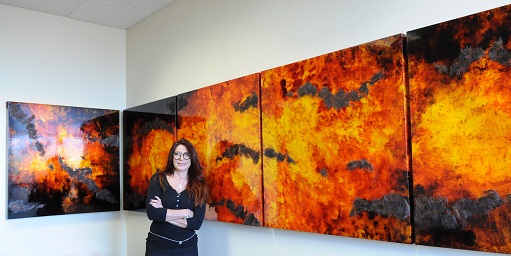
Human Rights & the Arts
The arts have always been a component of the Rapoport Center’s advocacy and programming. We have long recognized their power to inform understandings of human rights and to move audiences to action. Since our first conference, we have ensured that nearly all major events have an arts component, whether it be literature, music, theatre, dance, or visual arts. Examples include a symposium on insourcing and outsourcing of labor that featured, prior to each panel, Living Newspaper sketches written and performed by UT graduate students; a conference on El Salvador that opened with a photography exhibition on the Salvadoran civil war at the Harry Ransom Center; and a conference entitled “Aftershocks: Legacies of Conflict” that opened at Bass Concert Hall with the National Theatre Scotland’s production of Black Watch, a play exploring the experiences of a Scottish infantry battalion during the Iraq War.
Read more about our commitment to the arts below.

“Film, literature, and the arts are media that enable people to talk about human rights…Thanks to the ambivalence of aesthetic language, artworks are always open to interpretations and, in this way, they offer a democratic, flexible manner to set a conversation in motion.”
– Professor Luis Cárcamo-Huechante (Spanish & Portuguese), former head of the Human Rights & the Arts working group
Film Series
The Human Rights & the Arts working group’s inaugural event consisted of a screening and discussion of Chilean filmmaker, Patricio Guzmán’s documentary, Nostalgia de la Luz (Nostalgia for the Light). The documentary follows several Chilean women in their quest for relatives who were disappeared during Augusto Pinochet’s authoritarian regime (1973-1990). After the screening, Professors Luis Cárcamo-Huechante (Spanish & Portuguese) and Zipporah Wiseman (Law) spoke about the representation of human rights in the film. Other screenings and discussions involved former Rapoport Center co-director Dan Brinks’ discussion on the film Tropa de Elite (The Elite Squad), directed by José Padilha.
Workshops
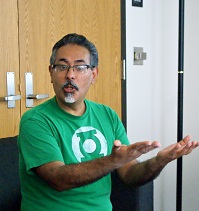
University of California San Diego associate professor Ricardo Dominguez’s work was the subject of the inaugural workshop held by the Human Rights & the Arts working group in the spring of 2012. Dominguez is co-founder of The Electronic Disturbance Theater, a group who developed virtual sit-in technologies in 1998 in solidarity with the Zapatista movement in Southern Mexico. Currently, he is at work on a “Transborder Immigrant Tool,” a GPS-enabled cell phone that facilitates the dangerous desert border crossing between the U.S. and Mexico by guiding migrants to safe routes, to water, and to sympathetic groups while avoiding the border patrol and civilian militias.
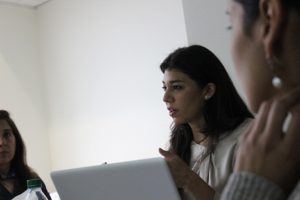
The Working Group hosted a second workshop in January 2013 featuring the work of Adriana Corral, a UT MFA student, which focuses on the femicides in Ciudad Juárez.
Exhibit
For most of 2012, the Rapoport Center doubled as an art gallery for Venezuelan artist Mery Godigna Collet’s Extra Virgin Petrus Oil. The exhibit, composed of three pieces titled Pure Energy, Sweet Oil, and MV Solar I, serves to highlight our intricate relationship to petroleum through the medium of the oil itself. Though oil is the primary material, Godigna Collet also uses patches of sugar cane fiber to represent the emergence of ethanol as an energy source. Karen Engle, co-director of the Rapoport Center, noted how “the artwork has literally ‘framed our year’. Not only does the work address issues of our dependence on oil as an energy source and on the human rights consequences of that reliance, but it does so from the perspective of a female artist.” Collet’s work functioned as a backdrop for the Rapoport Center’s eighth annual conference, Property Rights and the Human Rights Agenda, that took place March 1-2, 2012.
Image, Memory, and the Paradox of Peace: 15 years after the El Salvador Peace Accords
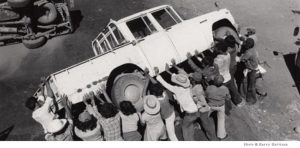
The Rapoport Center’s 4th annual conference centered around a historic collection of photojournalistic work acquired by the Harry Ransom Center that documents El Salvador’s 12-year civil war. In the spirit of the Rapoport Center, the conference brought together a multi-disciplinary group of academics, activists, artists, and policy-makers to explore the relationship between the local and the global, as well as the economic and the political. View the Harry Ransom Center’s Inside El Salvador photography exhibition here.
Aftershocks: Legacies of Conflict
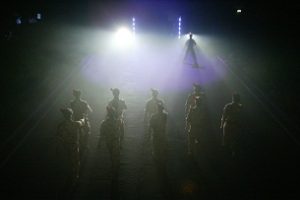
A performance of Black Watch, an award-winning Scottish play exploring the experiences of members of a Scottish infantry battalion in the Iraq War, anchored the Rapoport Center’s 7th annual conference, Aftershocks: Legacies of Conflict (February 17-18, 2011). Conference attendants and participants were encouraged to consider the contested legacies of conflict from artistic and historical perspectives in addition to a scholarly interpretation. Learn more about Black Watch here.
In cooperation with Joe Randel of ArtésAmericas and Lyn Wiltshire of the University of Texas’ Department of Theatre and Dance, the Rapoport Center collaborated with Álvaro Restrepo and his school of dance, El Colegio del Cuerpo. Established in Cartagena de Indias, Colombia by Colombian choreographer Álvaro Restrepo and co-directed by Marie France Delieuvin, El Colegio del Cuerpo is a school with a unique interdisciplinary focus. Existing as Colombia’s first contemporary dance center, the school focuses on respect for the body through dances that address topics ranging from human rights and social justice, to race and sexuality, to drug addiction. The most notable performance to come out of the collaboration was through the piece “Canción del Cuerpo” which featured choreographers from UT’s Theatre & Dance and company members from El Colegio del Cuerpo. Restrepo called the collaboration “a huge success…both as an artistic endeavor as well as a catalyst for dialogue on a variety of important issues facing Colombia today…[the experience] speaks eloquently of the power of the arts to affect change.”
The Rapoport Center collaborated with the Performing Arts Center to sponsor a teach-in on Guantánamo consisting of a photo presentation, Guantánamo: Pictures from Home, a dramatic reading of excerpts from the play Guantánamo: Honor Bound to Defend Freedom, and a conversation with Judith Rhedin on the links between human rights and the arts. In the words of Pebbles Wadsworth, director of the UT Performing Arts Center, the collaboration “has the potential to influence future generations to think creatively and outside the box about some of the most pressing issues of our times.”
The Rapoport Center acted as co-leader of the Living Newspaper project, a series of performances by high school students intended to reinvigorate civic education through dramatization of current human rights issues. The Living Newspaper, intended to be a newspaper brought to life in a theater performance, combines current events research, creative writing, and performance to influence and educate both the student performers and the audience on various issues related to human rights. The program is a collaboration between the Rapoport Center, the Humanities Institute, the Theatre Action Project, and the Performance as Public Practice Program of UT’s Department of Theatre and Dance.
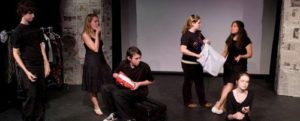
Related Events
- Nostalgia de la Luz Film Screening and Human Rights Discussion
- Tropa de Elite by José Padilha
- Aftershocks: Legacies of Conflict
- National Guantánamo Teach-In

